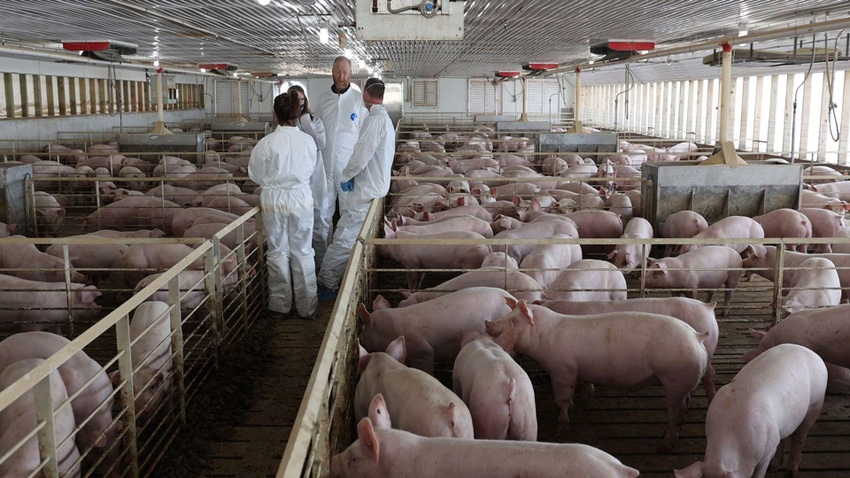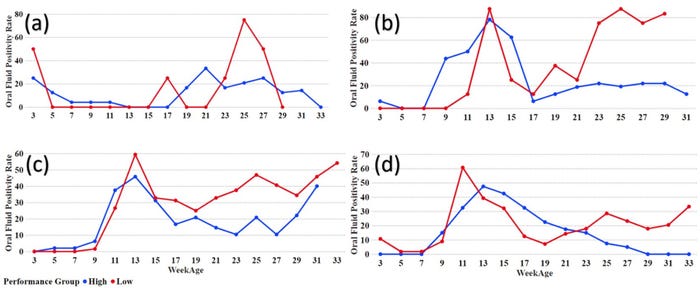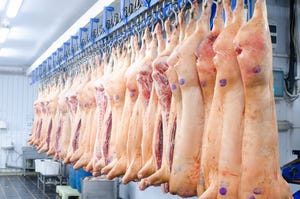Dynamic Pig Health: Unraveling patterns of swine pathogen co-infections
Dynamic Pig Health, a research collaboration from Iowa State University and Boehringer Ingelheim puts holistic swine health at the forefront.
March 1, 2024

By Guilherme Cezar, Kate Dion, Edison Magalhães, Daniel Linhares, Gustavo Silva and Giovani Trevisan, Iowa State University; Fernando Leite, Eduardo Fano, Reid Philips and John Waddell, Boehringer Ingelheim Animal Health USA Inc.
Pig herds are exposed to several pathogens that impact production performance. Some co-infections, such as those of the swine respiratory disease complex, have been well described along with their economic impact on farms1. However, co-infections among both respiratory and enteric pathogens remain poorly investigated. Dynamic Pig Health is a collaborative project of Iowa State University and Boehringer Ingelheim aiming to evaluate co-infections and their impact on farms to better understand the consequences of pathogen challenges in swine.
While there is evidence to suggest there could be an interaction among pathogens of the respiratory and gastrointestinal tract2,3, there is a lack of understanding of the degree and occurrence of these co-infections in the field. Similarly, there is a lack of understanding of the impact of these co-infections on production performance. This information is critical to better estimate the burden and economic impact of pathogens as they occur in the field and not in isolation as single swine pathogens, as is most commonly done.
In this study, the detection dynamics of Lawsonia intracellularis, an enteric pathogen, and porcine reproductive and respiratory syndrome virus, a systemic pathogen, were evaluated in wean-to-finish groups. These pathogens were selected as they represent key health challenges affecting the swine industry yet have seldom been evaluated together. The study evaluated the association of their detection with performance indicators to evaluate the consequences of this co-infection.
Key takeaways:
This study expands how we think about swine health and PRRSV. We often can’t identify why there is variability among performance indices and variation in the pig response to PRRSV. Some of this variation could potentially be explained by co-infections that aren’t always thought of, such as Lawsonia intracellularis infection, as identified in this study. It is important to recognize that disease and health are dynamic, depending upon interaction with multiple factors and other pathogens.
Among PRRSV-infected pigs, those with the worst production performance had significantly higher levels of Lawsonia intracellularis.
This study identified L. intracellularis infection as a variable associated with increased mortality and lower weight gain in PRRSV-positive pigs.
When evaluating pig health, it is important to have a holistic view and not just focus on one pathogen but understand that co-infections are common and multiple pathogens should be controlled to address the dynamics of health.
Study design
In this study, 36 groups of pigs sourced from sow farms classified4 as either PRRSV-stable (26 groups) or PRRSV-negative (10 groups) were monitored from weaning age until market. Oral fluid samples were collected biweekly at 16 time points from 3 to 33 weeks of age. The groups were classified as relatively “Low” or “High” performance based on mortality and average daily weight gain, using the 1st and 4th percentiles of the data, which means the worst and the best groups in terms of performance, these 36 groups were selected from a total of 76 groups. PCR tests were performed for PRRSV RNA and Lawsonia intracellularis DNA in each oral fluid collected from these groups. Groups were not vaccinated for PRRSV.
The study included over 46,446 growing pigs and 4,000 samples, characterized into 19 High and 17 Low-performance groups. The performance groups were statistically different in mortality (Low-performance, x̄= 12.1%; High-performance, x̄=6.9%) and ADG (Low-performance, x̄= 1.6 lb/day; High-performance, x̄= 1.8 lb/day). Among the 36 groups, PRRSV was detected in 35 groups, while Lawsonia was detected in 33 groups, demonstrating a very high exposure rate and co-detection of these two pathogens.
Among the co-infected groups of pigs, a higher detection rate of Lawsonia was observed in the Low-performance group (Figure 1). Low-performance groups also had a statistically significant (p<0.05) higher positivity rate for Lawsonia at the 25-week-of-age time point, regardless of when PRRSV was first detected. Interestingly, when PRRSV was first detected in the early finish period (between 11-13 weeks of age) the detection rate of Lawsonia also increased during this same period and remained higher in the Low-performance group until the pigs went to market (Figure 1c). It is possible that PRRSV may have contributed to higher levels of Lawsonia in these groups.

Figure 1. Pattern of Lawsonia intracellularis detection among High and Low performance groups of pigs exposed to natural field PRRSV challenge. Groups with PRRSV first detected in A) Early Nursery (3-5 weeks); B) Late Nursery (7-9 weeks); C) Early Finish (11-13 weeks); D) Late Finish (14 weeks onward). Photo submitted by Boehringer Ingelheim.
It is important to highlight that acute clinical presentation of diarrhea or mortality due to Lawsonia was not observed in any of the groups evaluated in this study. Therefore, these results shed light on the possibility that subclinical Lawsonia infection might be associated with worse performance outcomes in pigs that are exposed to PRRSV. This also points to the potential role of gut health and gut microbiome composition on respiratory disease5.
Acknowledgements:
The Dynamic Pig Health project was partly funded by Boehringer Ingelheim Animal Health USA Inc. and the Swine Health Information Center.
©2024 Boehringer Ingelheim Animal Health USA Inc., Duluth, GA. All Rights Reserved. US-POR-0004-2024
References
[1] Boeters M, Garcia-Morante B, van Schaik G, Segalés J, Rushton J, Steeneveld W. The economic impact of endemic respiratory disease in pigs and related interventions - a systematic review. Porcine Health Manag. 2023 Oct 17;9(1):45. doi: 10.1186/s40813-023-00342-w.
[2] Zhao, J., Wan, S., Sun, N., et al. Damage to intestinal barrier integrity in piglets caused by porcine reproductive and respiratory syndrome virus infection. Vet. Res. 52, 93 (2021).
[3] Argüello H, Rodríguez-Gómez IM, Sánchez-Carvajal JM, Pallares FJ, Díaz I, Cabrera-Rubio R, Crispie F, Cotter PD, Mateu E, Martín-Valls G, Carrasco L, Gómez-Laguna J. Porcine reproductive and respiratory syndrome virus impacts on gut microbiome in a strain virulence-dependent fashion. Microb Biotechnol. 15(3), 1007-1016 (2022).
[4] Holtkamp D, Torremorell M, Corzo CA, Linhares DCL, Almeida MN, Yeske P, Polson DD, Becton L, Snelson H, Donovan T, Pittman J, Johnson C, Vilalta C, Silva GS, Sanhueza J. Proposed modifications to porcine reproductive and respiratory syndrome virus herd classification. J Swine Health Prod. 2021;29(5):261-270.
[5] Ober RA, Thissen JB, Jaing CJ, Cino-Ozuna AG, Rowland RRR, Niederwerder MC. Increased microbiome diversity at the time of infection is associated with improved growth rates of pigs after co-infection with porcine reproductive and respiratory syndrome virus (PRRSV) and porcine circovirus type 2 (PCV2). Vet Microbiol. 2017 Sep;208:203-211.
You May Also Like

.png?width=300&auto=webp&quality=80&disable=upscale)


